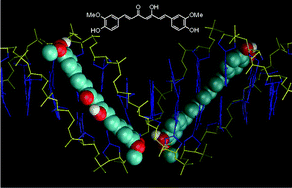Circular dichroism spectroscopic studies reveal pH dependent binding of curcumin in the minor groove of natural and synthetic nucleic acids†
Abstract
For the first time, an interaction between the non-toxic, cancer chemopreventive agent

* Corresponding authors
a
Institute of Biomolecular Chemistry, Chemical Research Center, P.O. Box 17, Budapest, Hungary
E-mail:
zsferi@chemres.hu
Fax: (+36) 1-325-7750
For the first time, an interaction between the non-toxic, cancer chemopreventive agent

 Please wait while we load your content...
Something went wrong. Try again?
Please wait while we load your content...
Something went wrong. Try again?
F. Zsila, Z. Bikádi and M. Simonyi, Org. Biomol. Chem., 2004, 2, 2902 DOI: 10.1039/B409724F
To request permission to reproduce material from this article, please go to the Copyright Clearance Center request page.
If you are an author contributing to an RSC publication, you do not need to request permission provided correct acknowledgement is given.
If you are the author of this article, you do not need to request permission to reproduce figures and diagrams provided correct acknowledgement is given. If you want to reproduce the whole article in a third-party publication (excluding your thesis/dissertation for which permission is not required) please go to the Copyright Clearance Center request page.
Read more about how to correctly acknowledge RSC content.
 Fetching data from CrossRef.
Fetching data from CrossRef.
This may take some time to load.
Loading related content
